Blogging The Insidious Dr. Fu-Manchu by Sax Rohmer – Part One: “The Zayat Kiss”
NOTE: The following article was first published on March 7, 2010. Thank you to John O’Neill for agreeing to reprint these early articles, so they are archived at Black Gate which has been my home for over 5 years and 250 articles now. Thank you to Deuce Richardson without whom I never would have found my way. Minor editorial changes have been made in some cases to the original text.
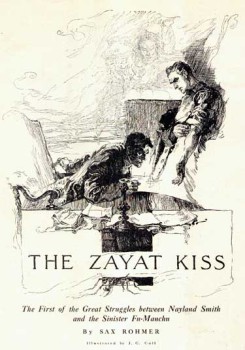
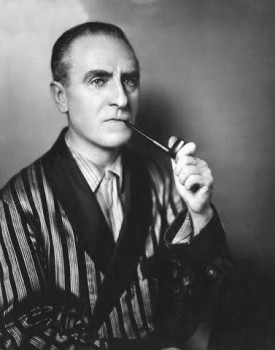 Arthur Henry Ward was born in England in 1883. His father hoped his son would make his way through life as a respectable businessman, but young Arthur was determined to make a name for himself as an author.
Arthur Henry Ward was born in England in 1883. His father hoped his son would make his way through life as a respectable businessman, but young Arthur was determined to make a name for himself as an author.
He discovered immortality with the invention of two unlikely monikers that conjured an air of exotic intrigue when they debuted in print a century ago. The first was his chosen pen name, Sax Rohmer and the second was the name of the character at the heart of his first published novel, Dr. Fu-Manchu.
Over the years, the name lost its hyphen and became synonymous with the moustache artists and actors always depicted the character as wearing despite the fact that he was always described in print as clean-shaven. Dr. Fu-Manchu is a brilliant and honorable scientist who is opposed to British colonial interference in the East. Using a variety of fiendish inventions, insects, and assassins, he sets out to remove Western influence and silence those who know too much about the East.
Most intriguing in our post-9/11 world, the Devil Doctor chooses to fight his battles not in China, but on British soil using terror as his weapon. He is opposed in his efforts by stalwart British colonialist Nayland Smith and Smith’s bodyguard and Fu-Manchu’s chronicler, Dr. Petrie. Rohmer’s stories spanned five decades moving in real time with his characters aging alongside their author. For much of the first half of the last century, Dr. Fu-Manchu was the villain readers loved to hate.
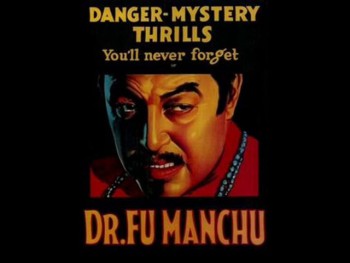
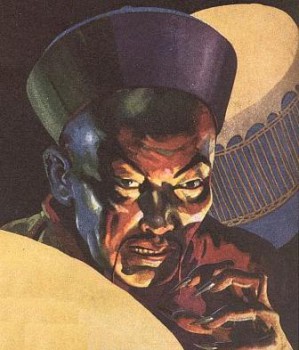 Born out of imperialist Britain’s fear of a Yellow Peril emerging from the East, Rohmer ingeniously imbued his fictional villain with greater intelligence and integrity than his Western protagonists.
Born out of imperialist Britain’s fear of a Yellow Peril emerging from the East, Rohmer ingeniously imbued his fictional villain with greater intelligence and integrity than his Western protagonists.
Dr. Fu-Manchu was introduced in October 1912 in the pages of “The Zayat Kiss,” a thrilling tale borrowing heavily from Sir Arthur Conan Doyle’s “The Speckled Band” complete with the Holmesian duo of Burmese Police Commissioner Nayland Smith and his loyal friend and assistant, Dr. Petrie.
Readers of Britain’s The Story-Teller were delighted with the results and the story became the first of a collection its author titled simply, Fu-Manchu.
The unflappable duo of Smith and Petrie repeatedly strive to save Men Who Know Too Much about China from assassination at the hands of Dr. Fu-Manchu’s dacoit servants or the various poisonous reptiles, insects, and biological agents at his disposal. These colorful intended victims begin with cocaine-addicted Sir Crichton Davey who dies with a mysterious imprint of a woman’s lips on the back of his hand mumbling the words, “the red hand” in his delirium.
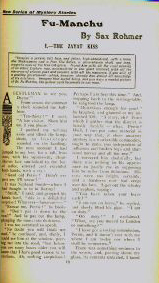 The title of the collection was amended to The Mystery of Dr. Fu-Manchu when it was published in book form by Cassell in June 1913 while American publisher, McBride & Nast preferred The Insidious Dr. Fu-Manchu as a variant title for its US publication in October of that same year. Whatever the title, the storied collection was a smashing success and readers clamored for more. For a time, Sax Rohmer was quite happy to deliver.
The title of the collection was amended to The Mystery of Dr. Fu-Manchu when it was published in book form by Cassell in June 1913 while American publisher, McBride & Nast preferred The Insidious Dr. Fu-Manchu as a variant title for its US publication in October of that same year. Whatever the title, the storied collection was a smashing success and readers clamored for more. For a time, Sax Rohmer was quite happy to deliver.
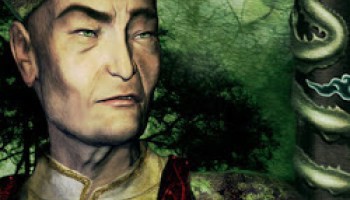 Fu-Manchu’s foremost literary antecedents were Sherlock Holmes’ nemesis, Professor Moriarty and Guy Boothby’s now forgotten criminal mastermind, Dr. Nikola. Rohmer’s initial description of the character in “The Zayat Kiss” is unforgettable and one that Rohmer would strive to re-create over the years without ever falling into direct imitation:
Fu-Manchu’s foremost literary antecedents were Sherlock Holmes’ nemesis, Professor Moriarty and Guy Boothby’s now forgotten criminal mastermind, Dr. Nikola. Rohmer’s initial description of the character in “The Zayat Kiss” is unforgettable and one that Rohmer would strive to re-create over the years without ever falling into direct imitation:
‘Imagine a person, tall, lean, and feline, high-shouldered, with a brow like Shakespeare and a face like Satan, a close-shaven skull, and long, magnetic eyes of the true-cat green. Invest him with all the cruel cunning of an entire Eastern race, accumulated in one giant intellect, with all the resources of science past and present, with all the resources, if you will, of a wealthy government – which, however, already has denied all knowledge of his existence. Imagine that awful being, and you have a mental picture of Dr. Fu-Manchu, the yellow peril incarnate in one man.”
Dr. Fu-Manchu does not even make a physical appearance in the story, yet his presence pervades the atmosphere and hysteria of “The Zayat Kiss” from the first moment when Burmese Police Commissioner Nayland Smith turns up unannounced and unexpected at the residence of his childhood friend, Dr. Petrie – a staid suburban medical practitioner with aspirations to write weird fiction – and leads him into a mad world filled with conspiracy theories, bizarre assassinations, and a lovesick half-caste Egyptian slave girl who forms an immediate attachment on Petrie and ends up saving his and, by association, Nayland Smith’s life for the first of many times in this story. There was no way the story could not have been a smashing success when it debuted in print in October 1912. All of the ingredients were there to build a winning formula. How Rohmer did just that without growing tired and repetitious will be the subject of future installments in this blog.
William Patrick Maynard was licensed by the Sax Rohmer Literary Estate to continue the Fu Manchu thrillers beginning with The Terror of Fu Manchu (2009; Black Coat Press) and The Destiny of Fu Manchu (2012; Black Coat Press). The Triumph of Fu Manchu is coming soon from Black Coat Press.